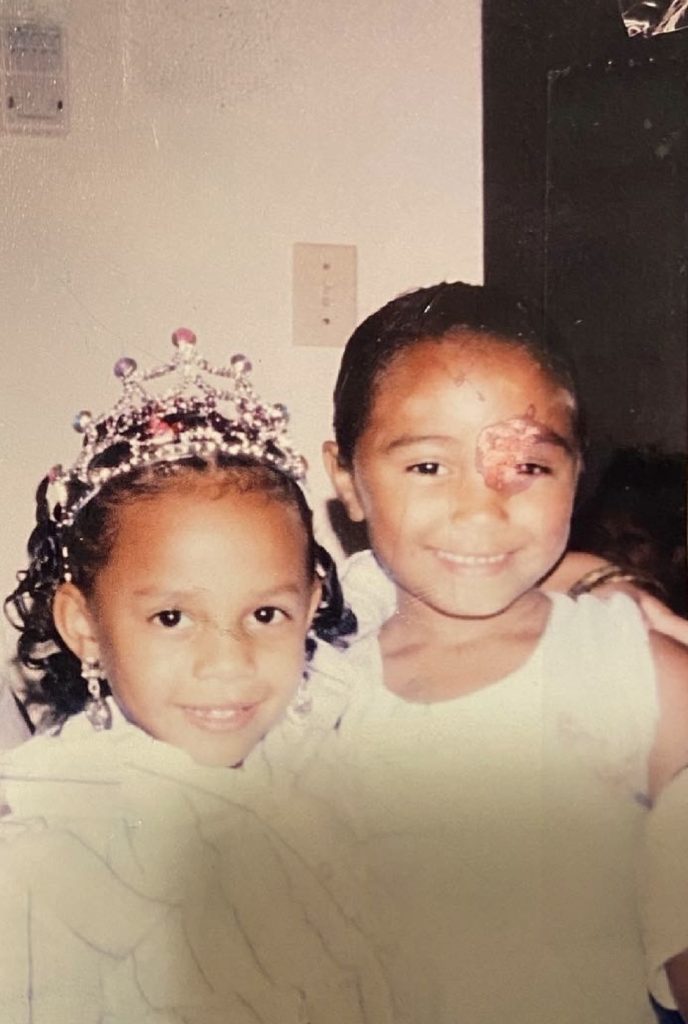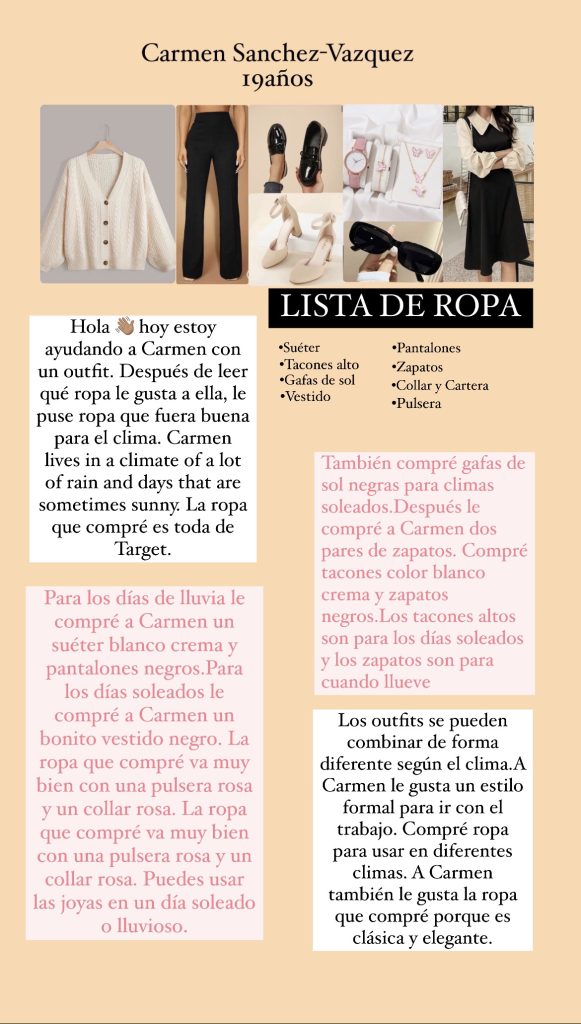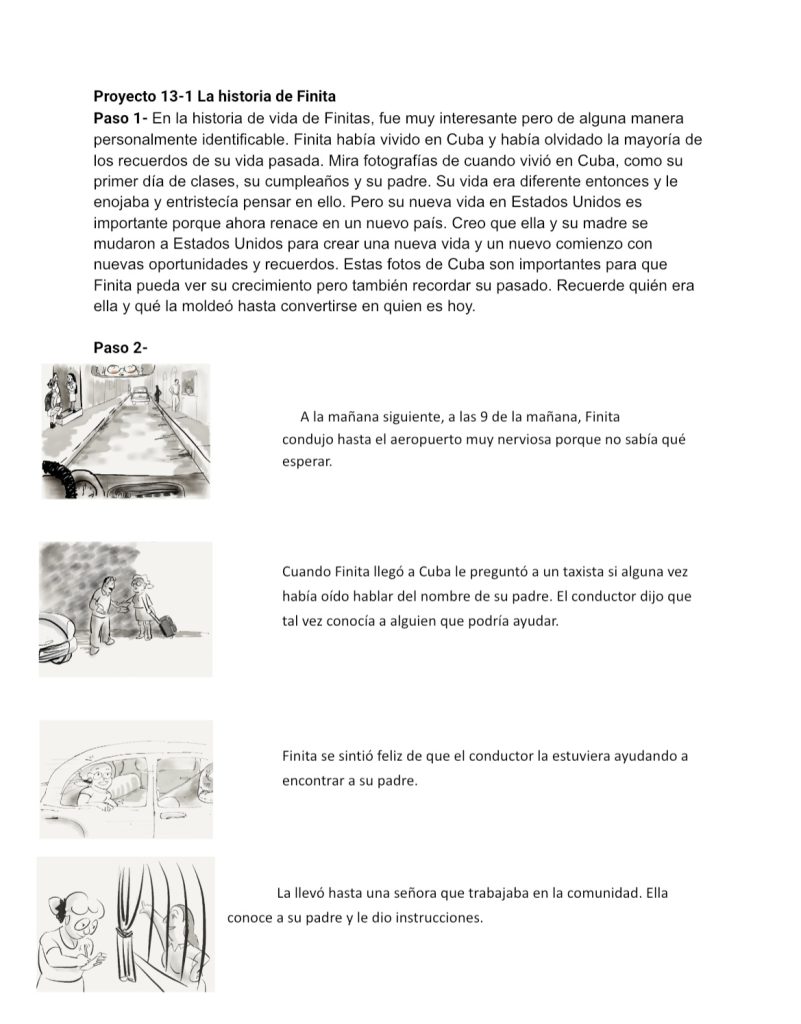Interpretive, Interpersonal, and Presentational Modes of Communication
Exploring Culture
During this semester I have learned tremendously from my professor, peers, and classmates. They have not only expanded my skills in the Spanish language but also helped me gain knowledge of the Spanish culture. Another aspect that helped in understanding the Latin culture was the required application needed to pass the course called “Contrasena Lingrolearning”. Also, the application TalkAbroad helped me conduct conversations with people who lived in Spanish-speaking countries.
These practices not only corrected my mistakes but taught me ways in which I can improve my skills. For instance, the website Lingrolearning was I took that I have used for the past 3 years to gain knowledge in comprehension in Spanish. This site provided reading logs and lecture videos that contained information about that week’s unit. After the prerequisites, we were able to complete a quiz that contained either multiple choice, fill-in-the-blank, or match words to certain pictures and boxes. These homework sessions were conducted in preparation, applying the material learned, checking the answers, and then reflecting. It was needless to say that Lingrolearning was challenging but turned our academics into an entertaining way to educate ourselves in the Spanish language. It also taught me differences in perspectives as it provided information about the various types of culture in these Spanish-speaking countries. There were also projects in the class that had us explain the culture and activities done in these countries in this project, I talked about the culture and traditions of Colombia. It was an experience to converse with people who were located in these countries and learn about their day-to-day and their countries’ cultures from our Talabroad assignments. These aspects demonstrated ways in which assisted my personal growth, knowledge, and abilities in the Spanish language.
Link to cultural project: https://www.youtube.com/watch?v=6nsXv4N_hgk
Engaging in Communities
I must engage with my community. Spanish is the 2nd most spoken language in the United States and there have been countless times when I have visited, places such as New York, Flordia, or California where people have mistaken me to be of Spanish descent. Although I have Spaniards in me, most of my family members are actually from Spanish-speaking countries and are prone to their culture and traditions. This is my cousin Christina she is from Spain. She doesn’t know much English but engaging with one another throughout the years has sincerely helped me carry conversations in Spanish and have the confidence to initiate.
This is important as I get to teach her English while she teaches me Spanish. It’s an amazing experience to gain another Knowledge about our origins and countries. It’s beneficial because learning a language improves your memory, you can effectively speak and communicate with people all around the world, you can help others with the skill, and connect with other humans who are located in different areas around us and form meaningful relationships.

Interpersonal Communication
For me, TalkAbroad was a very rare experience. Before, I had never actually spoken in Spanish for more than fifteen minutes at a time. I had to finish two Talkabroad audios in which I had to have a Spanish-speaking conversation with a foreign speaker. The individuals I conversed with were fluent in the language and had great patience and understanding. This experience taught me that my speaking companions were always there to offer advice and corrections. My conversation topics might include my family, sports, my favorite pastimes, foods I enjoy cooking, and so forth. Additionally, the discussion boards we used in class, where I would respond to questions in Spanish with a partner depended on what Professor Gordus presented on the board.
In terms of my ability to communicate in Spanish, I think I have much improved. I think this way because this semester, I have covered a lot of ground in terms of vocabulary in all the subjects I have studied. On the other hand, I do get anxious when I speak this language. I find it difficult to match the right verb to the right viewpoint, whether it be they, us, or he/she. This semester, my professor has consistently incorporated exercises that will aid in my understanding of these blunders when speaking Spanish. That being said, I still think my Spanish has improved.
Presentational Speaking
Speaking is one of the biggest portions of communicating in Spanish. I learned how to confidently speak in Spanish. At the beginning of the semester, my professor announced how I make mistakes and how we are there to learn Spanish. I appreciated his speech because it helped remind me that we are here to learn and I shouldn’t be ashamed or embarrassed when communicating aloud in Spanish. At the beginning of each class, my professor presents a questionnaire in Spanish for us to converse with our peers regarding what questions were asked. After me and my partners helped each other out we were then able to share our answers with the class. Although my Spanish isn’t perfect I know I have a safe environment to speak in Spanish as our classmates and professors help each other. We must help and support one another to create a beneficial learning space.
Due to this, I grew the strength to talk aloud in my class about the projects I have completed during this year’s semester. I would participate and share my documents and then explain them in Spanish. In this project, I created a clothes board which I´ve learned from the lingo learning post. Here’s an image.

Presentational Writing
During this semester, we would as a class write a composition which was a written portion once we completed our unit project. Practicing writing short essays and articles has helped when it comes to writing letters to Spanish-speaking people and conducting articles and short essays.
Although, writing is probably my weakest skill, being in this class helped me step out of the box and work with my peers so we can all give corrections and improvements to our growing abilities. I was very lucky to have classmates who would study outside of class with me to help me with my writing. The link provided below was one of the projects in which we had to create a historic article. I talked about Martin Luther King jr as I had a lot of knowledge about and wrote a piece due to certain keywords that I knew could help describe MLKJ as an inspiring activist in United States history.
https://docs.google.com/document/d/1bwCE0oQXscUKNAKg4drc_p4S8FxqrYHJ2Vrkfg0_nLo/edit?usp=sharing
Interpretive Listening
Some of the activities we talked about were speaking activities where we had to talk to a partner of a few students. This was helpful because my classmates would help me out by correcting me if I was having some issues with incorrect answers as I spoke. We would all help each other out and share ideas, At the start of the semester, when my professor spoke in Spanish, I had some issues understanding what he was saying. But as time went on, I started to get a better grasp on what was being said. To this day, I still have some trouble understanding fast-spoken Spanish. But when it’s spoken clearly and you’re using hand gestures, I can use context clues to understand what’s being said. I think that continuing to practice more and more will help me as I learn Spanish.
During TalkAbroad I learned how to listen and then respond. I usually grasp the keywords that I hear and understand. Or I would listen to words that sound familiar in my original language. These skills have helped me navigate real-life instances where I have spoken the Spanish language to people while I’m in public places such as grocery stores, festivals, and Uber rides. Listening is a big part of understanding the language.
Interpretive Reading
Interpretive communication activities I read this semester would be reading about a girl from Cuba named Finita’s experiences as an immigrant while keeping in mind what I´ve learned about immigration patterns in the Spanish-speaking world and creating it into my own story. This project was a learning lesson and assisted in reinforcing my creative skills. I ordered images chronically and explained each picture in Spanish using my context tools and gathering some background from the stories the article provided. Reading about her experiences helped make creating my own story as a continuation of Finita’s easier.

Activities involving interpretive communication were crucial. These exercises improved my speaking, listening, and reading comprehension of Spanish during my Spanish lesson. The primary platform for these activities was the Lingro Learning web application, which demonstrated how to pronounce words correctly. They would give us reading passages to respond to, and we were to utilize the context clues to get the answers. In class, my lecturer would write paragraphs in Spanish on the board, which we would then read aloud. Given that I learn best visually and that the English text included some conjugated words, the reading portion of the assignment could seem simpler. Though it was challenging to overcome my inner struggles, knowing that others persisted in teaching me helped strengthen my Spanish-speaking abilities despite the obstacles.